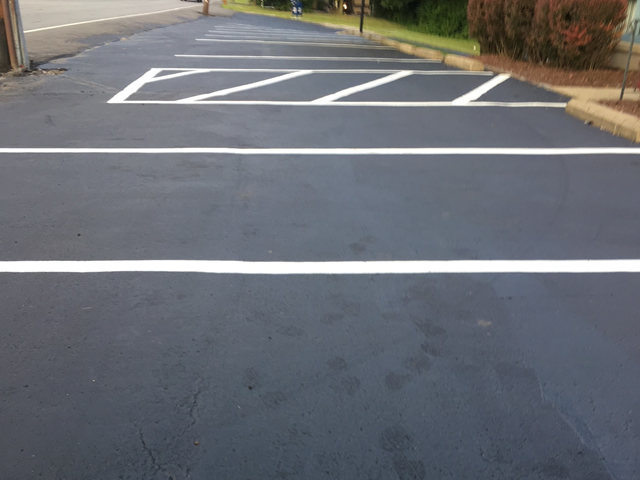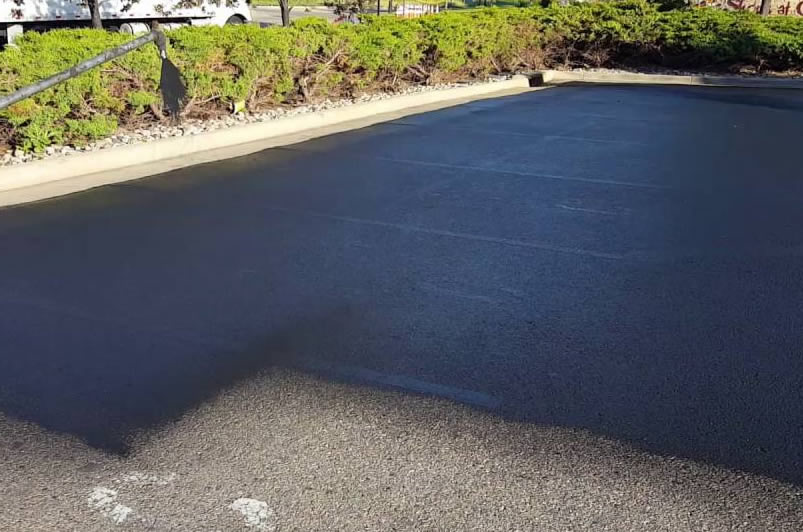How Often Should You Seal and Stripe a Parking Lot?
Parking lots should generally be sealed every 2-3 years and striped every 1-2 years, depending on traffic volume, weather conditions, and the quality of the initial installation. Proper maintenance not only prolongs the life of your parking lot but also ensures safety and aesthetics for your customers.
Why Is It Important to Seal and Stripe Regularly?
Sealing and striping are essential for maintaining the durability, safety, and appearance of your parking lot. Sealcoating protects the surface from elements like UV rays, water, and chemicals, which can lead to cracks and potholes. Striping ensures clear and visible parking spaces, which helps with traffic flow, maximizes available space, and enhances customer safety.


Factors That Influence How Often You Should Seal and Stripe a Parking Lot
- Traffic Volume
The more vehicles your parking lot handles daily, the more wear and tear it experiences. High-traffic lots may need to be striped every year to ensure that lines are clearly visible. Similarly, sealing may be required every 2 years in high-use lots to prevent surface damage. - Weather Conditions
Extreme weather can significantly affect how often your lot should be maintained. In areas with freezing winters, snow, ice, and salt can damage the asphalt, necessitating more frequent sealing. In hotter climates, UV rays can break down the surface over time. These factors may require you to seal and stripe more often than in mild climates. - Parking Lot Material
The type of asphalt or pavement material used in your parking lot also plays a role. Higher-quality materials can often go longer between sealings and striping. If your lot was constructed using premium materials, you may be able to stretch maintenance intervals by an additional year or so.
Signs That Your Parking Lot Needs Restriping
- Faded Lines and Markings
If the parking spaces, directional arrows, or other markings are starting to fade or become difficult to see, it’s time to restripe. This not only improves the appearance but also enhances safety by preventing confusion for drivers. - Reduced Traffic Flow Efficiency
As lines fade, customers may park improperly, taking up more space than necessary, which can reduce the capacity of your parking lot. Clear striping ensures that vehicles park within designated spaces and traffic flows smoothly. - Safety Concerns
Poorly marked lots can lead to accidents, either from cars colliding or pedestrians being hit. Visible crosswalks, directional arrows, and parking spaces are critical for maintaining a safe environment for both drivers and pedestrians.
When Should You Seal a Parking Lot?
- Cracks and Surface Deterioration
If you notice cracks, potholes, or other surface damage, it’s time to reseal. Sealing fills minor cracks, preventing water from penetrating the surface and causing further damage. - Fading Color
Over time, asphalt begins to lose its rich, dark color, turning gray as it ages. If your lot is looking weathered or dull, sealing can restore its appearance and protect the underlying surface from further degradation.
What Happens If You Don’t Seal and Stripe on Time?
- Decreased Curb Appeal
A faded and cracked parking lot looks uninviting and may give customers the impression that your business is not well-maintained. Regular sealing and striping improve your property’s aesthetics, which can leave a positive impression on visitors. - Increased Repair Costs
Neglecting to seal and stripe can lead to significant deterioration over time. Small cracks can turn into large potholes, requiring costly repairs. Routine maintenance is more affordable than letting the lot degrade to the point of needing major repairs or resurfacing. - Safety Hazards
Faded lines and a damaged surface can create safety hazards for both drivers and pedestrians. Clear markings reduce the likelihood of accidents and ensure that your parking lot remains compliant with regulations, such as ADA guidelines.
How Long Do Sealing and Striping Take?
- Sealing Process
Sealing a parking lot typically takes 24-48 hours, including drying time. It’s essential to schedule this maintenance during off-peak hours or when your business is closed to avoid disrupting customer traffic. - Striping Process
Striping usually takes a few hours, depending on the size of the lot, and the area can often be reopened for use within 30 minutes to an hour after the paint is applied. If sealing and striping are done together, the sealing must be completed first, and the lot should fully dry before striping.
Create a Maintenance Schedule for Your Parking Lot
For optimal results, create a maintenance schedule tailored to your specific parking lot. Plan to seal every 2-3 years and stripe every 1-2 years, or as soon as you notice fading or damage. By staying proactive, you’ll save money in the long run and provide a safer, more attractive environment for your customers.
If you’re uncertain about the condition of your parking lot, a professional parking lot maintenance company can provide an assessment and recommend the best schedule for sealing and striping based on the factors unique to your location and usage patterns.

